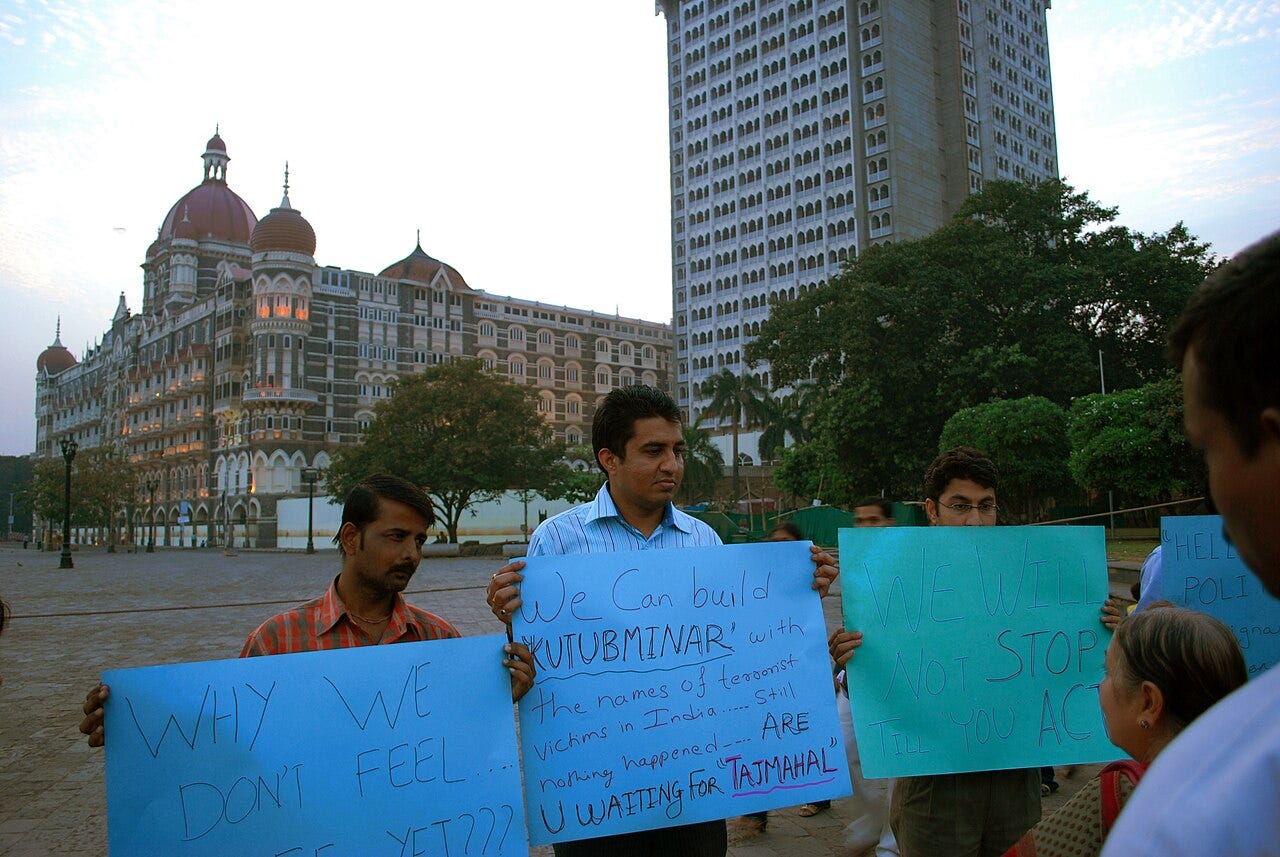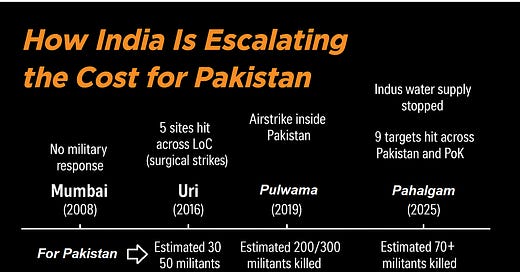From Restraint to Retaliation: The Doctrine Behind India’s Operation Sindoor
Raising the Cost. India’s New Equation with Pakistan
Every attack should carry a cost.
That, it seems, was the quiet conclusion drawn by India’s national security establishment in the wake of the 2016 Uri attacks. Since then, India has steadily, deliberately raised the price of cross-border terror. At the core of this calibrated escalation—carefully kept below the nuclear threshold—is a lesson learned the hard way: Mumbai, 2008.
On the night of November 26, 2008, India watched in disbelief as ten gunmen from Pakistan laid siege to Mumbai. They attacked with chilling precision—opening fire at train stations, hotels, and cafés in the heart of the country’s financial capital. The attack dragged on for nearly three days. By the end, 166 people were dead: commuters, tourists, police officers, and soldiers.
I was in India then, watching it unfold live on TV. Switched it off. Switched it back on. Couldn’t stop. It went on and on, hour after hour. Day after day.
What followed was national fury.

Across India, there were calls for justice, for action. But what India delivered instead were statements—stern diplomatic protests, dossiers of evidence handed to Islamabad, and appeals to the international community. Even as it became clear that the attackers had links to Pakistan’s Lashkar-e-Taiba and were supported by elements within Pakistan’s security establishment, nothing came out of it.
The message that silence sent was not just internal. In Islamabad—and more importantly, in Rawalpindi—it was read as something else entirely: India will absorb pain, but will not respond with force. In the shadowed corridors of Pakistan’s military-intelligence complex, 26/11 did not just mark a successful terrorist operation—it validated a strategy.
The nuclear umbrella gave Pakistan a license to bleed India through targeted terror attacks.
For years after 26/11, the pattern held firm. India bled—slowly, persistently. Cross-border terror attacks persisted. Politicians issued condemnations. Security forces adjusted. But across the border, little shifted. For Pakistan, the cost remained minimal. The specter of war felt remote—almost unreal.
That calculus would shift.
In September 2016, four heavily armed militants infiltrated the Indian Army’s brigade headquarters in Uri, near the Line of Control in Jammu and Kashmir. In the early hours of the morning, they lobbed grenades into tents, setting off fires and killing 19 soldiers—the deadliest such attack on Indian forces in years. The attackers were, once again, traced back to Pakistan.
But this time, the response would be different.
By then, the political landscape in India had changed. A new government, elected in 2014, had brought Narendra Modi to power. His National Security Advisor, Ajit Doval—a former Intelligence Bureau chief—had long championed a shift in India’s approach to cross-border terrorism. His vision was clear: “defensive offence”—a strategy to keep India’s posture restrained at the strategic level but called for precise, forceful retaliation to raise the cost for Pakistan’s continued support of terror.
Under Doval’s guidance, India’s doctrine quietly evolved. The era of restraint was ending. The reliance on statements, evidence dossiers, and international appeals gave way to a doctrine of measured, visible response—designed not to escalate, but to impose consequences.
Uri was the inflection point. The message from New Delhi was no longer one of endurance. It was one of intent.
Eleven days after the attack, India announced that its Army had carried out surgical strikes across the Line of Control. Special Forces crossed into Pakistan-occupied Kashmir and destroyed several launch pads used by militants preparing to infiltrate. The operation was limited in scale, tightly choreographed, and deliberately public. Covert raids had happened before—but this was the first time India claimed one openly.
This was more than a tactical operation. It was a declaration of doctrine.
For the first time since 1971, India had crossed the Line of Control and openly acknowledged it—without triggering a full-blown war. The risk threshold had been tested. And Pakistan’s response was revealing.
Islamabad denied the strikes outright. Military officials dismissed India’s claims as fiction, insisting that nothing beyond routine cross-border firing had occurred. It was a carefully chosen narrative—one that allowed Pakistan to save face domestically while avoiding the obligation to respond militarily. For all its bluster, Pakistan took no action.
In New Delhi, that silence was interpreted as validation. The cost of inaction had been too high for too long, but now a calibrated response—forceful, limited, and deliberate—was possible. A message had been sent, and the sky hadn’t fallen. India had crossed a line—literally and doctrinally—and Pakistan had blinked.
Still, the scale of retaliation remained constrained. The strikes were surgical in name and nature—targeted, brief, and geographically limited. They signaled intent, not yet capacity. But the psychological shift was undeniable. The old doctrine of restraint had been publicly set aside.
A new doctrine was taking shape—quietly, deliberately, and under Ajit Doval’s watch.
On February 14, 2019, a suicide bomber drove a vehicle packed with explosives into a convoy of CRPF personnel in Pulwama, Jammu and Kashmir. Forty Indian paramilitary soldiers were killed—the single deadliest terror attack in the region in decades. The group claiming responsibility: Jaish-e-Mohammad (JeM), operating from deep inside Pakistan.
The message, once again, was bloody and clear.
But this time, India’s response wasn’t limited to the Line of Control. In the early hours of February 26, Indian Air Force jets crossed the border and struck a Jaish-e-Mohammad training camp in Balakot, Khyber Pakhtunkhwa—well beyond Pakistan-occupied Kashmir. It was a clear application of the Doval doctrine: raise the cost, strike deeper, force a recalculation.
Unlike the surgical strikes of 2016, this operation couldn’t be denied or dismissed. It was widely reported—inside Pakistan and internationally—leaving Islamabad with little room to maneuver. This time, Pakistan had to respond.
Within 24 hours, it did. On February 27, Pakistani fighter jets entered Indian airspace and targeted military installations in Jammu and Kashmir. In the dogfight that followed, an Indian MiG-21 Bison was shot down. Its pilot, Wing Commander Abhinandan Varthaman, was captured after ejecting into Pakistan-occupied territory.

For a brief, tense moment, South Asia stood on the edge of a broader conflict. It was the Imran Khan government that found a way to de-escalate—returning the captured wing commander and defusing a crisis that could have spiraled further.
Still, the line had shifted. Balakot marked a new kind of response—no longer confined to PoK, no longer covert. It showed that India was willing to raise the stakes, to project airpower, and to accept operational risks. But even then, the strike was targeted. It hit one training camp.
That would change in 2025.
Keep reading with a 7-day free trial
Subscribe to The Concis to keep reading this post and get 7 days of free access to the full post archives.




